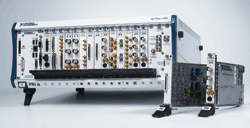Modular instruments make real the promise of PXIe
If you haven’t actually tried to build instrumentation based on a common backplane standard, it may seem simple: just add the bus connector and wire it up. But there’s really a lot more to it than that.
National Instruments’ development of instruments based on PCI Express with extensions for instrumentation (PXIe) is a case in point. The first true PXIe instruments — the PXIe-5122 100-Msample/s 100-MHz digitizer and PXIe-6537/6536 digital I/O modules — which NI began shipping in May 2007 and for which it received a 2007 Product of the Year Award in January of this year, actually had their origins back in 1997.
That year Mark Wetzel, a Principal Engineer at NI, was involved with the groups working on the specifications for PCI. National itself was working on developing the specifications for an instrumentation bus based on PCI, adding to that basic data structure a means of sharing timing signals based somewhat on the architecture of VXI, which was derived from the VME bus.

The following year NI gave its instrumentation bus specification to the newly formed PXI Systems Alliance with no strings attached: the Alliance controls the rights to PXI. Mark served the Alliance as chairman of the technology development group, and as such was in close contact with counterpart in the Compact PCI community.
When it was determined that PCI would be extended to become the PCI Express bus, Mark was instrumental in making sure that the new bus would have two key attributes: it would provide a smooth transition from the old configuration to the new, and that the structure would allow the signals needed by instrumentation for timing.
Were NI’s only work in the standards committee, they might not have been first into the market with high-performance PXIe products. But in parallel with but independent of its standards work, NI worked closely with Intel and AMD to understand the processor and bus technologies they were developing.
At the same time, it was necessary to make sure that high-speed designs could be realized at prices that would allow users to build test systems economically, yet still provide scalability to protect investments. By applying its in-depth knowledge of ASIC design, NI was able to fulfill these requirements, and the 6.6-GHz PXIe cards unveiled last month more than validated its PXIe approach.
Richard Comerford
Advertisement
Learn more about National Instruments





